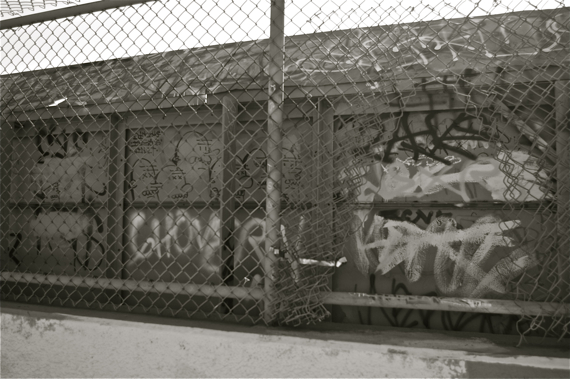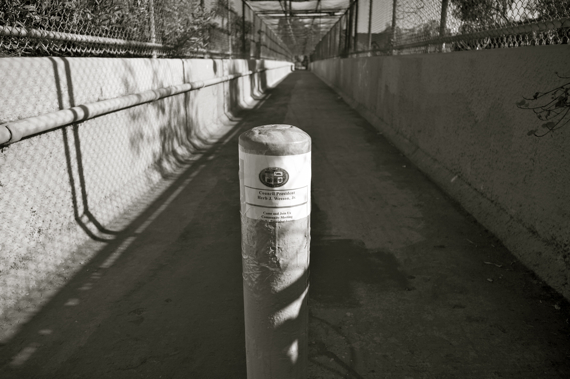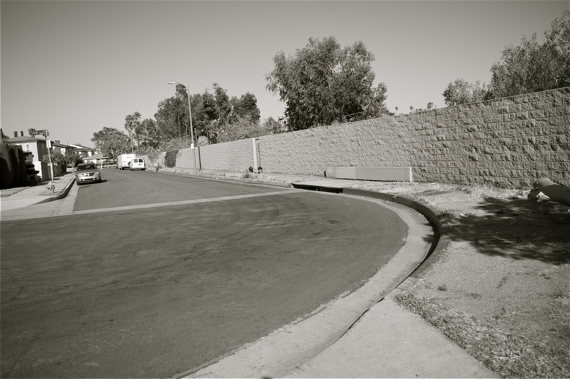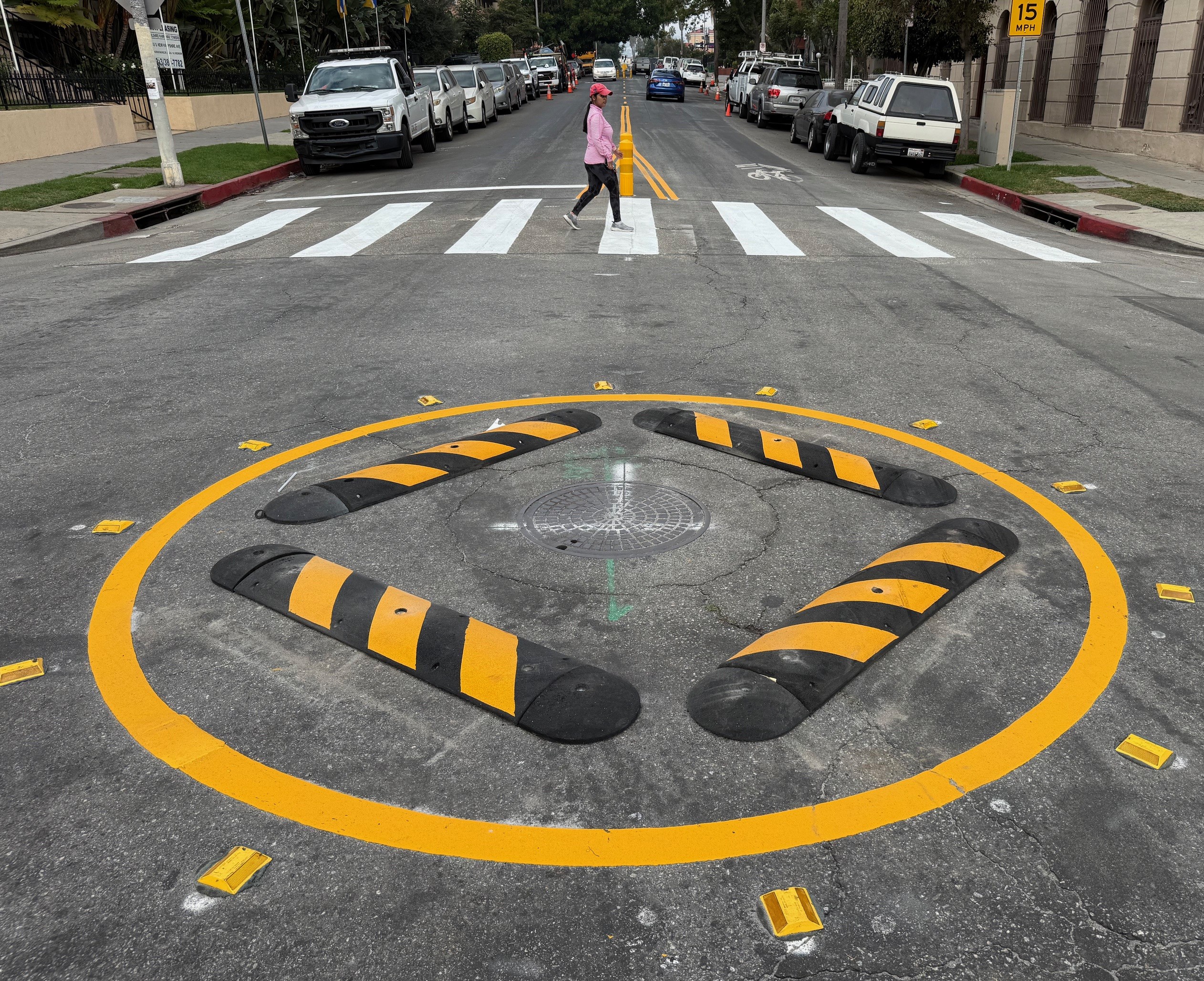"We've all stopped and wondered, 'What kind of poop is this?'" a man said of the surprises the 4th Ave. pedestrian bridge sometimes holds for residents of Jefferson Park and Arlington Heights.
That wasn't reason enough to close the bridge, however, he told the crowd of concerned neighbors and homeowners that had gathered at Herb Wesson's District Office Monday night to discuss the fate of the area's lone remaining pedestrian walkway over the 10 freeway.
Take the case of his disabled son, he argued.
The boy was able to walk from the north side of the 10 to the park (located two blocks form the bridge) every day because of the bridge. Closing it would force his son to walk several extra blocks and likely leave him too exhausted to go regularly or play once he got there.
The benefits to keeping the bridge open far outweighed the risks, he said.
He would be one of many that night who would suggest that neighbors needed to come together to take ownership of the bridge to discourage the kinds detrimental behaviors a semi-secluded and not-particularly-well-lit pedestrian bridge often invites.
Just what kind of behaviors are those?
According to some, prostitution, gang activity, crime (where the bridge serves as an "escape route"), drug use, graffiti, and urination and/or defecation.
"Close it!" muttered a gentleman who lives next to the bridge.
He was tired of the criminal activity and of people using his driveway (there are no curb cuts on the south entrance to the bridge). And, law enforcement was completely disinterested in dealing with the problems the bridge generated, he said, leaving him and other neighbors vulnerable.
People sympathized with his and others' concerns and acknowledged the area had seen its share of problems.
What wasn't clear, however, was the frequency with which these problems occurred or their relationship to the bridge.
Listening to some of the meeting-goers, it sounded like raucous and wanton law-breaking was the constant state of perilous affairs on the bridge. Street interviews conducted with residents and others who use the bridge on a daily basis painted a completely different picture -- one of a peaceful, safe, and kid-friendly crossing.

Neighbors living on both sides of the bridge I spoke with indicated that it was relatively quiet, even at night.
A man who lived next to it on the north side said he occasionally would forget to lock his car door, but never found anything stolen in the morning or had any other issues in the three years he'd been there.
Another couple living next to it on the south side said that, because of overnight parking permit restrictions in their area, they sometimes had to park on the north side of the 10. Even late at night, they said, they felt safe crossing the bridge to get home and had never encountered anyone engaged in criminal activity.
Kids who go back and forth to school or to the park on a daily basis, and who are perhaps the most frequent users of the bridge, all gave me some variation of, "I use it every day and I've never had any trouble."
Even the one consistently visible crime -- graffiti on the bridge -- seems to be the work of young taggers looking to get their names out there. It is not, as some neighbors at the meeting seemed to fear, the work of gangs marking their territory to sell drugs or for other nefarious purposes. The kids interviewed didn't appreciate the graffiti, but they never had run-ins with anyone writing on the bridge, so it wasn't a deterrent to their use of it.
In fact, many were shocked and puzzled to hear that the bridge's fate might be up for debate.
"No!!" gasped a girl in her early teens on her way to the park. "Please tell them we want them to keep it open!"
"We go through here every day!" her friend nodded. "If they closed it, we'd have to walk all the way around..." she pointed towards the busy Arlington bridge.
They were right to be concerned about having to use Arlington.
A look at crime data for the past several months indicates that the few reported crimes taking place along neighborhood streets tend to be theft from vehicles and are not happening in proximity to the bridge. More importantly, the majority of the reported -- and more violent -- crime takes place on or near major thoroughfares like Arlington that facilitate quick getaways. Forcing kids to take Arlington could inadvertently make them easy targets for robbery or assault, even in broad daylight.
So, who is right and whose interests need to be protected?

"What's the radius? Who gets to decide [the fate of the bridge]?" demanded the man who wanted the bridge closed.
He was not alone in his displeasure at the idea that anyone who uses it could have a say.
There were apparently a number of very heated emails that went back and forth between some of the homeowners and neighbors prior to the meeting. And, efforts to spread the word about the meeting to bridge users were hampered by whomever pulled down or tore apart flyers about the event within hours of their having gone up (see above photo).
To his credit, Kimani Black, Deputy - South West of Council District 10, deftly steered neighbors in the direction of positivity.
More than once that night, he reminded attendees both to keep things civil and that closure of the bridge was the last resort.
The first remedies would be the installation of cameras and better lighting. The district would also ask that law enforcement better patrol the area and drive into (rather than past) the cul-de-sacs and streets that dead-ended at the freeway, as these were the spots where illicit activity was most likely to occur.

What he wanted to hear from attendees that night, Black said, were suggestions for solutions that would improve the quality of life in the neighborhood but also address the real concerns that had plagued the homeowners for some time.
Thankfully, there were a number of residents on hand to offer both suggestions and their willingness to participate in evening events, beautification projects, clean-up days, and the like. Citing successes in taking back other parks and trouble spots in the neighborhood, several neighbors proclaimed that they were confident that, together, they could reclaim the bridge, too. Doing so would not only strengthen community and deter criminal activity, they suggested, but possibly even help mitigate some of the long-standing tensions between some of the neighbors.
Putting things in perspective, one of the long-time residents and last speakers of the evening noted that "the bridge is [in] the best [shape] I've seen it in years."
It didn't mean there weren't problems -- he recounted an incident where he personally chased a john clad only in underwear all the way to Western Ave. while on the phone with police.
But, it didn't mean something couldn't be done.
"We have control over that bridge," he said. The real question is, "How do we exercise that control?"
Do you live in the area and/or use the 4th Ave. bridge? Do you have suggestions for how safety and security around the bridge and surrounding neighborhood might be improved? Contact CD 10's Kimani Black at kimani.black@lacity.org with your ideas.







